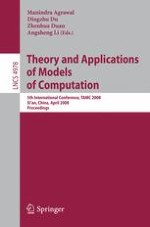2008 | Book
Theory and Applications of Models of Computation
5th International Conference, TAMC 2008, Xi’an, China, April 25-29, 2008. Proceedings
Editors: Manindra Agrawal, Dingzhu Du, Zhenhua Duan, Angsheng Li
Publisher: Springer Berlin Heidelberg
Book Series : Lecture Notes in Computer Science
